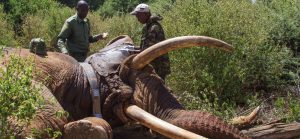
Last month, faithful Save the Elephants (STE) followers might remember that a large tusker named Matt gave us quite the scare when he lost his collar in Northern Kenya. Well, when I say, “lost his collar”, what I really mean is that he yanked it off. A massive 7-8 ton bull with huge tusks, Matt had already removed 3 previous collars before pulling this one off so he has a bit of a reputation. Nevertheless, because he is such a rare, old (mid 40s) bull, we desperately wanted to recollar him to keep track of his wanderings and to monitor him against poachers.
Imagine our surprise when we heard that he had been spotted in Samburu this past weekend! Matt is currently in musth, a period of sexual activity in males, and has apparently traveled hundreds of kilometers in search of females, ending up right by our camp. Unfortunately, the vet was not available until Thursday May 8, so for the rest of the week, we looked for Matt every day to make sure that we would be able to find him come collaring time. On Wednesday night, Matt was spotted very close to camp, but when dealing with males in musth, it is hard to predict whether they will stay put or travel many kilometers away during the night.
David decided that we would get started at 7AM on Thursday to look for Matt, and the next day, three separate search teams set out to find him. For the first hour, things were not looking good, but David has magical elephant tracking abilities and patiently waited near the Ewaso river to see whether Matt was hiding behind some bushes (for a large animal, elephants can hide surprisingly well!). Amazingly, after a few minutes, Matt emerged from behind the bushes and into plain view. Now that we found him, we were faced with the new challenge of where to tranquilize him. Because he was located right at the south bank of the river, it made for challenging logistics since we couldn’t predict which side of the river he would end up on.
After some frantic conversations in Swahili, of which I was excited to realize I understood a tiny amount, we set off to meet up with the vet. By this time, Matt had crossed over to the North side of the river into Samburu, and we decided to just go for it. I rode in the car with the vet and David as we pursued Matt a little off the road. David had previously warned me that Matt might charge us after getting darted, so I was a little nervous but also excited to see what would happen! When we got a clear view of Matt’s side, the vet took the shot and Matt immediately took off trotting away from us.
Luckily, he didn’t run too far away and about 15 minutes later, he started getting a little wobbly and then went down. The collaring itself was a blur as we all worked to collar Matt as quickly as possible. Large bulls like Matt can overheat quickly, and we wanted to minimize the amount of time he was under anesthetics. I was amazed at how efficiently everyone functioned – the STE crew and Kenya Wildlife Services rangers worked on securing the collar, pouring water on Matt’s ears and body to keep him cool, and picking off ticks.

In about 20 minutes, we had finished collaring him, and then the vet drew some blood from his ears and STE made some measurements of his tusks and body. Finally, the vet gave the signal that he was about to administer the antidote, and we all jumped into the cars in case we needed to make a speedy getaway. A couple of minutes after receiving the antidote, Matt got slowly onto his feet, gave us a dirty look (maybe) and slowly walked away. I finally got a chance to reflect on what just happened and feel so privileged that I was able to get so close and personal with this magnificent being. Hopefully this reinforced collar will remain on Matt for years, and we will be able to follow this old bull on his journeys all over Kenya!

